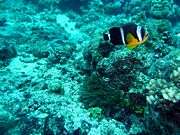Amphiprion chrysogaster
Amphiprion chrysogaster, the Mauritian anemonefish, is a marine fish belonging to the family Pomacentridae, the clownfishes and damselfishes. It is endemic to Mauritius and probably Réunion.[1]
| Amphiprion chrysogaster | |
|---|---|
| Scientific classification | |
| Kingdom: | Animalia |
| Phylum: | Chordata |
| Class: | Actinopterygii |
| Family: | Pomacentridae |
| Genus: | Amphiprion |
| Species: | A. chrysogaster |
| Binomial name | |
| Amphiprion chrysogaster Cuvier, 1830 | |
Characteristics of Anemonefish
Clownfish or anemonefish are fishes that, in the wild, form symbiotic mutualisms with sea anemones and are unaffected by the stinging tentacles of the host anemone, see Amphiprioninae § Symbiosis and mutualism. The sea anemone protects the clownfish from predators, as well as providing food through the scraps left from the anemone's meals and occasional dead anemone tentacles. In return, the clownfish defends the anemone from its predators, and parasites.[2] Clownfish are small-sized, 10–18 centimetres (3.9–7.1 in), and depending on species, they are overall yellow, orange, or a reddish or blackish color, and many show white bars or patches. Within species there may be color variations, most commonly according to distribution, but also based on sex, age and host anemone. Clownfish are found in warmer waters of the Indian and Pacific oceans and the Red Sea in sheltered reefs or in shallow lagoons.
In a group of clownfish, there is a strict dominance hierarchy. The largest and most aggressive fish is female and is found at the top. Only two clownfish, a male and a female, in a group reproduce through external fertilization. Clownfish are sequential hermaphrodites, meaning that they develop into males first, and when they mature, they become females.
Description
Adults are very dark brown, nearly black with three white bars. The snout and breast are orange. The caudal fin is blackish or dark brown and the anal fin may be blackish or orange-yellow.[1] They have 10 dorsal spines, 2 anal spines, 16-17 dorsal soft rays and 13-14 anal soft rays.[3] They reach a maximum length of 14 cm (5 1⁄2 in).[1]
Color variations
Fish that are generally blackish except for the three white bars are associated with the host anemone Stichodactyla mertensii, Mertens' carpet sea anemone.[1]
Similar species
The Seychelles anemonefish, A. fuscocaudatus, is distinguished by location, the number of dorsal spines and the solid dark tail of A. chrysogaster compared with dark streaks on the tail of A. fuscocaudatus. A. tricinctus (Three-band anemonefish) is also distinguished by location, being found only in the Marshall Islands in the Pacific and has a narrower bar across the tail base than A. chrysogaster[1]
 A. chrysogaster (Mauritian anemonefish)
A. chrysogaster (Mauritian anemonefish) A. fuscocaudatus (Seychelles anemonefish)
A. fuscocaudatus (Seychelles anemonefish)
Distribution and Habitat
The Mauritian anemonefish is found only in Mauritius and probably Réunion.[1]
Host anemones
The Mauritian anemonefish is hosted by the following species of anemones:[1][n 1]
- Heteractis magnifica magnificent sea anemone
- Stichodactyla haddoni
- Stichodactyla mertensii Mertens' carpet sea anemone
Notes
- Macrodactyla doreensis was recorded [1] as a host of A. chrysogaster, however this was an error.[4]
References
- Fautin, Daphne G.; Allen, Gerald R. (1997). Field Guide to Anemone Fishes and Their Host Sea Anemones. Western Australian Museum. ISBN 9780730983651. Archived from the original on 14 April 2015.
- "Clown Anemonefish". Nat Geo Wild : Animals. National Geographic Society. Retrieved 2011-12-19.
- Froese, Rainer and Pauly, Daniel, eds. (2011). "Amphiprion chrysogaster" in FishBase. January 2011 version.
- Ollerton J; McCollin D; Fautin DG; Allen GR. (2007). "Finding NEMO: nestedness engendered by mutualistic organization in anemonefish and their hosts". Proc R Soc B Biol Sci. 274: 591–598. doi:10.1098/rspb.2006.3758. PMC 1766375. PMID 17476781.
External links
| Wikimedia Commons has media related to Amphiprion chrysogaster. |
| Wikispecies has information related to Amphiprion chrysogaster |
- "Amphiprion chrysogaster". Integrated Taxonomic Information System.
- Amphiprion chrysogaster. Cuvier, 1830. Retrieved through: World Register of Marine Species.
- Photos of Amphiprion chrysogaster on Sealife Collection